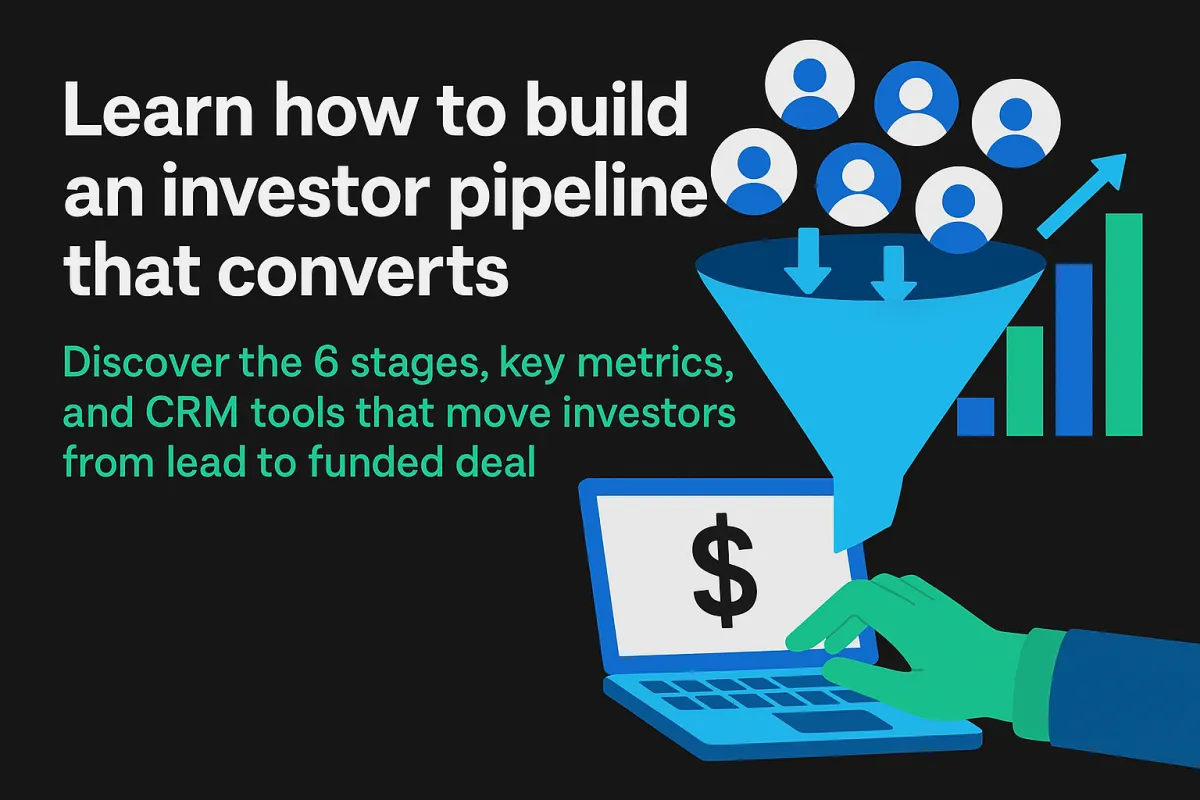
Investor Pipeline Guide: Stages, Metrics & CRM Tools
How to Build an Investor Pipeline That Actually Converts: Stages, Metrics & CRM Tools
Raising capital isn’t about blasting emails and hoping for commitments. The raising capital process works best when it’s structured as an investor pipeline rather than a generic sales funnel.
The problem is, most capital raisers try to force their business into a generic sales pipeline (lead → opportunity → closed). That doesn’t fit. Investors don’t act like SaaS buyers, and they need to be nurtured differently.
In this guide, we’ll show you how to structure an investor pipeline that actually converts and why the right CRM makes all the difference.
What Is an Investor Pipeline?
An investor pipeline is a structured way to track relationships with potential and current investors. Instead of treating people like “leads,” you’re mapping out their journey from first touch to funded deal.
Investor Pipeline vs. Sales Pipeline
In most businesses, a sales pipeline is about transactions. A rep identifies a lead, qualifies them, negotiates, and closes the deal. The cycle is designed to be fast and repeatable.
A syndicator, by contrast, isn’t selling a SaaS subscription or a product demo. They’re inviting someone to trust them with capital for months or years. That means the investor pipeline is less about closing a quick deal and more about building credibility over time.
Sales pipelines track transactions. Investor pipelines track relationships and trust.
That difference matters, because investors don’t close in one call. They often need education, reassurance, and time.
The 6 Investor Pipeline Stages Every Capital Raising CRM Should Have
Here are the six investor pipeline stages every capital raiser should track to increase conversion rates. The best capital raising CRMs are designed to follow stages like these:
Stage 1 – New Lead
Someone downloads a guide, attends a webinar, or gets referred. They’ve shown interest but aren’t ready to invest yet.
Stage 2 – Engaged
They’ve interacted more than once (joined a webinar, read multiple emails, followed you on LinkedIn). At this stage, your goal is to provide education and credibility. For a multifamily syndicator, an engaged investor might mean they toured a property or reviewed a pro forma.
Stage 3 – Interested
They’ve expressed explicit interest in a deal or asked for more details. This is where you introduce the Deal Room and answer high-level questions.
Stage 4 – Soft Commit
The investor signals they’re ready to reserve a spot. A soft commit workflow confirms their amount and holds their place.
Stage 5 – Docs Out
They’ve been sent subscription documents. Timely follow-up here is critical — many investors stall in this stage without a reminder.
Stage 6 – Funded
The final stage: money wired, investor onboarded. The CRM should automatically tag them for future updates and distributions.
CapBloom brings all of these investor pipeline stages together in one place, making the capital raising process simple, repeatable, and transparent. To see how a CRM built specifically for investors can streamline your raise, contact our sales team for a personalized demonstration.
Key Metrics to Track for Investor Pipeline Success
A healthy pipeline isn’t just about stages, it’s about movement. At its core, an investor pipeline is a form of investor tracking, helping you monitor progress and optimize results. The best CRMs for raising capital let you track:
Conversion rates between stages (e.g., % moving from Interested → Soft Commit)
Time spent in each stage (long delays = bottlenecks).
Total soft commits vs. funded (forecasting tool for your raise).
How a CRM Simplifies Investor Pipeline Management
Unlike a generic fundraising CRM, a capital raising CRM is built specifically to manage investor relationships from first touch to funded deal.
You can try to track this in spreadsheets, but as soon as you have more than 20 investors, it breaks. A capital raising CRM automates the process by:
Automatically moving contacts between stages when they fill a form or click a link.
Sending reminders to investors in “Docs Out.”
Segmenting by accreditation, check size, or deal readiness.
Reporting on pipeline health so you know where to focus.
Want to see how automation saves time? Schedule a call to learn why CapBloom is a better choice for investors over a generic CRM.
Investor Pipeline in Action
Here’s what it looks like inside a dedicated real estate syndication CRM like CapBloom:
A new lead downloads your “Guide to Multifamily Investing.”
They’re automatically added to Stage 1 (New Lead) and tagged.
They attend a webinar → the CRM moves them to Stage 2 (Engaged).
They click on the Deal Room → move to Stage 3 (Interested).
They submit a soft commit form → automatically added to Stage 4 (Soft Commit).
Workflow triggers: subscription docs sent, reminders go out, and once funded, they’re tagged for ongoing updates.
That’s a pipeline that actually works. This kind of deal flow management ensures no investor slips through the cracks, and every commitment is nurtured to completion. All without manual tracking.
Simplify Your Capital Raising with an Investor-Focused CRM
If you’re still trying to manage investors with spreadsheets or a generic sales CRM, you’re leaving money on the table.
CapBloom was built specifically as a capital raising CRM with investor pipelines pre-built for syndicators, fund managers, and real estate investors. It combines investor relations management with pipeline tracking, so you can scale your capital raising without losing the personal touch.
Book a Demo and see how CapBloom can help you build an investor pipeline that actually converts.










